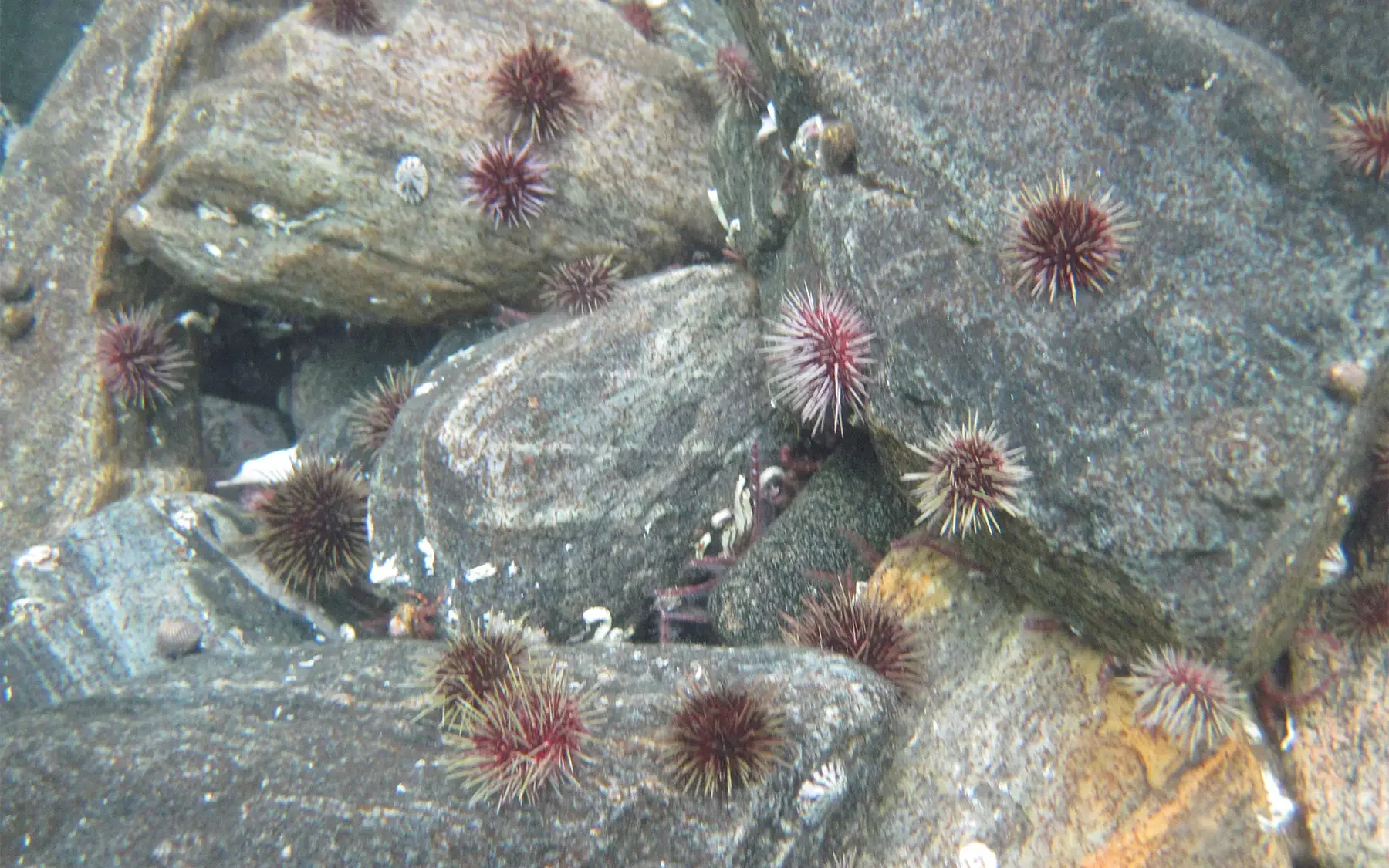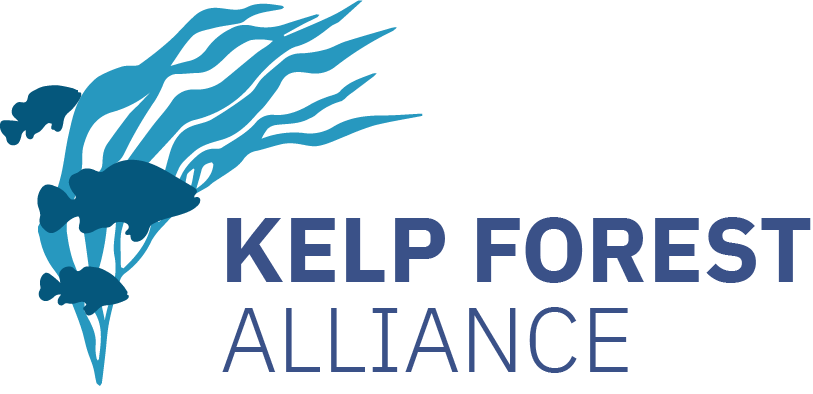Key takeaways
Application of quicklime is effective in reducing urchin densities in cool-temperate conditions (5-10 °C), but future studies are needed to better understand the causes of variable results and quantify non-target mortality.
Quickliming is most effective when urchins are relatively large and hiding places are few. To effectively treat urchin barrens with the optimal quicklime particle sizes below depths of ~5 m, surface application is unlikely to be effective.
Background
Norway has the largest continuous kelp forest in Europe, and one of the largest in the world 1 2. However, an explosive increase in Strongylocentrotus droebachiensis sea urchin populations in the 1970s resulted in the most severe grazing event observed in the Northeast Atlantic 3. The large increase in sea urchin densities was probably caused by overfishing of urchin predators in the coastal zone in the 1950-60s 4. Approximately 2000 km2 of ‘cuvie’ (Laminaria hyperborea) was lost during these grazing events 5, and later estimates also suggest that sugar kelp (Saccharina latissima) and other marine vegetation were denuded over several times that area in the fjords and inner sheltered regions of the coast 6.
The project
Since sea urchin gonads are a highly valued seafood product, a harvest fishery would be the preferred option for sea urchin control. However, gonad content in urchins on barrens is typically too low to be commercially viable, and although ‘fattening’ protocols have been successful at lab scale 7, they have not yet been successfully implemented at commercial scales. One alternative to a fishery and to aid kelp restoration is to cull the sea urchins using an environmentally friendly chemical such as quicklime.
Quicklime, or calcium oxide (CaO), is produced by heating ordinary lime (calcium carbonate, CaCO3) to ~1000 °C. When the quicklime is mixed with water, it reacts back to lime. The reaction is exothermic and produces a short-lived but highly alkaline environment that is highly damaging to echinoderms (urchins, sea stars sea cucumbers etc.), but to which creatures protected by shells (e.g., snails, mussels, crabs, etc.) or slime (e.g., fish) are less susceptible. In 2008, the Norwegian Institute of Marine Research (IMR), in collaboration with the Norwegian Institute for Water Research (NIVA) and the private lime enterprise Franzefoss Minerals AS, started to test whether quicklime could reduce sea urchin stocks on barrens in the north of Norway. The initial inspiration to test this quickliming method came from Californian and Canadian studies 8. However, those studies were somewhat discouraging because they hinted that lower water temperatures may have been responsible for the less successful applications of quicklime in colder Canadian waters relative to California. Since water temperatures in the north of Norway are regularly below 10 °C, and we commenced our first tests in late autumn when temperatures were below 5 °C, we started out very cautiously with the application of only a few tens of kilograms of quicklime, followed by larger tests of several hundred kilograms in the waters near the research station.
Despite the low temperatures, we observed high sea urchin mortality, and the following year we recorded abundant kelp recovery in the treated areas, while nearby untreated sites remained barren and dominated by sea urchins. The likely source of the new kelp recruits was nearby (i.e., 10-100 m) residual patches and individual kelp from exposed locations and crevices, which were protected from urchins. After several additional studies in the lab and field, we conducted a large-scale liming experiment where we applied 200 ton over ~0.6 km2 of urchin barren. Similarly, these applications caused high sea urchin mortality and abundant kelp recovery (Fig. 1).
However, when we decided to apply the same protocol in another large-scale experiment in a different fjord system in 2017, the results were discouraging, with almost no kelp recovery in the year following treatment. Follow-up studies led us to conclude that although the treatment caused high urchin mortality, there were still substantial numbers of small unaffected urchin recruits hiding in the gravel, with the potential to emerge and feed on kelp sporelings as they settled throughout the winter 9 (Fig. 2).
Figure 1 Treatment of stable sea urchin barrens with quicklime in the Porsangerfjord resulted in kelp recovery within a year. Photos provided by the authors.
Figure 1 Treatment of stable sea urchin barrens with quicklime in the Porsangerfjord resulted in kelp recovery within a year. Photos provided by the authors.
Lessons learned
These trials revealed that quicklime treatment can turn stable urchin barrens into dense kelp forests within a year, even in cold temperate waters (5-10 °C), although treatment efficiency was probably less dependent on temperature than the quicklime particle size and bottom topography. As such, habitats rich in refuges must probably be treated several times. In those instances, we anticipate that repeated treatments should be spaced two to three weeks apart to fully evaluate the effect of the previous treatment. The required reduction in urchin density to facilitate kelp recovery will depend on urchin species, temperature, timing between quicklime treatments, and kelp sporeling settlement, among much else. All these factors must probably be decided for each region in question.
We have only developed and scaled the method of applying quicklime from the surface (Fig. 1), which is most efficient in shallow areas. A more precise and efficient method of applying the smaller (more effective) quicklime particles and at greater depths remains a major challenge for research and development. Ultimately, the overall method is not fully developed and still considered a work in progress, although the industry indicates an eventual treatment cost ~US$1/m2.
Barrens in Norwegian waters are typically completely dominated by urchins, and thus little collateral damage to other wildlife will occur during quickliming treatment. However, barrens elsewhere can be populated with valuable and potentially vulnerable species like abalone. No toxic residuals are produced during treatment. Indeed, the main concern of environmental authorities is non-target mortality, and so they will currently only sanction use of quicklime in scientific studies.
Figure 2 In habitats rich in refuges, quicklime will still cause high sea urchin mortalities on the surface; however, chances are that unaffected individuals will also emerge from underneath and keep the habitat barren. This picture shows an untreated habitat. Photos provided by the authors
Figure 2 In habitats rich in refuges, quicklime will still cause high sea urchin mortalities on the surface; however, chances are that unaffected individuals will also emerge from underneath and keep the habitat barren. This picture shows the same habitat a few days after treatment. Photos provided by the authors
References
10 Bernstein BB,Welsford RW. 1982. An assessment of feasibility of using high-calcium quicklime as an experimental tool for research into kelp bed/sea urchin ecosystems in Nova Scotia. Can Tech Rep Fish Aquat Sci 968:1-51.
11 Gundersen H,Christie H,de Wit H,Norderhaug K,Bekkby T,Walday M. 2010. Utredning om CO2-opptak i marine naturtyper. In: NIVA. p 25.
12 Norderhaug KM,Christie HC. 2009. Sea urchin grazing and kelp re-vegetation in the NE Atlantic. Marine Biology Research 5:515-528 DOI: 10.1080/17451000902932985.
13 Norderhaug KM,Nedreaas K,Huserbråten M,Moland E. 2020. Depletion of coastal predatory fish sub-stocks coincided with the largest sea urchin grazing event observed in the NE Atlantic. Ambio:1-11.
14 Pedersen MF,Nejrup LB,Fredriksen S,Christie H,Norderhaug KM. 2012. Effects of wave exposure on population structure, demography, biomass and productivity of the kelp Laminaria hyperborea. Marine Ecology-Progress Series 451:45-60 DOI: 10.3354/meps09594.
15 Pessarrodona A,Moore PJ,Sayer MDJ,Smale DA. 2018. Carbon assimilation and transfer through kelp forests in the NE Atlantic is diminished under a warmer ocean climate. Global Change Biology 24:4386-4398 DOI: https://doi.org/10.1111/gcb.14303.
16 Siikavuopio SI,Christiansen JS,Dale T. 2006. Effects of temperature and season on gonad growth and feed intake in the green sea urchin (Strongylocentrotus droebachiensis). Aquaculture 255:389-394.
17Sivertsen K. 1997. Dynamics of sea urchins and kelp during overgrazing of kelp forests along the Norwegian coast. In: NFH: Tromsø. p 127.
18 Strand HK,Christie H,Fagerli CW,Mengede M,Moy F. 2020. Optimizing the use of quicklime (CaO) for sea urchin management—a lab and field study. Ecological Engineering: X:100018.








